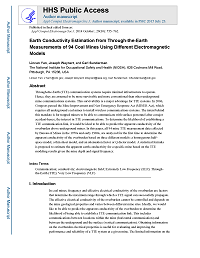Mining Publication: Earth Conductivity Estimation from Through-the-Earth Measurements of 94 Coal Mines Using Different Electromagnetic Models
Original creation date: October 2014
Through-the-Earth (TTE) communication systems require minimal infrastructure to operate. Hence, they are assumed to be more survivable and more conventional than other underground mine communications systems. This survivability is a major advantage for TTE systems. In 2006, Congress passed the Mine Improvement and New Emergency Response Act (MINER Act), which requires all underground coal mines to install wireless communications systems. The intent behind this mandate is for trapped miners to be able to communicate with surface personnel after a major accident—hence, the interest in TTE communications. To determine the likelihood of establishing a TTE communication link, it would be ideal to be able to predict the apparent conductivity of the overburden above underground mines. In this paper, all 94 mine TTE measurement data collected by Bureau of Mines in the 1970s and early 1980s, are analyzed for the first time to determine the apparent conductivity of the overburden based on three different models: a homogenous half-space model, a thin sheet model, and an attenuation factor or Q-factor model. A statistical formula is proposed to estimate the apparent earth conductivity for a specific mine based on the TTE modeling results given the mine depth and signal frequency.
Authors: L Yan, JA Waynert, CB Sunderman
Peer Reviewed Journal Article - October 2014
NIOSHTIC2 Number: 20045395
Appl Comput Electromagn Soc J 2014 Oct; 29(10):755-762
See Also
- Advanced Tutorial on Wireless Communication and Electronic Tracking: Introduction
- Magnetic Communication System (MCS)
- Passive Fiber Optic System for Locating, Tracking, and Communicating with Personnel in Coal Mines
- Preliminary Performance Predictions For Electromagnetic Through-The-Earth Mine Communications: A Collection of Working Memoranda
- System Reliability and Environmental Survivability
- Theoretical Noise and Propagation Models for Through-the-earth Communication
- Through-the-Earth (TTE) Communications: Range Reliability Improvements
- Through-The-Earth Wireless Real-Time Two-Way Voice Communications
- Two-Way, Through-the-Earth Emergency Communication System for Trapped Miners and the Surface
- Wireless Through-The-Earth Modeling and Support
- Content source: National Institute for Occupational Safety and Health, Mining Program


 ShareCompartir
ShareCompartir
